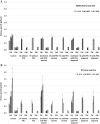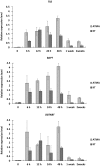Comparison of elicitor-based effects on metabolic responses of Taxus × media hairy roots in perfluorodecalin-supported two-phase culture system
- PMID: 30406280
- PMCID: PMC6320355
- DOI: 10.1007/s00299-018-2351-0
Comparison of elicitor-based effects on metabolic responses of Taxus × media hairy roots in perfluorodecalin-supported two-phase culture system
Abstract
Two lines of Taxus × media hairy roots harbouring or not the TXS transgene demonstrated diverse gene expression and taxane yield during cultivation in PFD-supported two liquid-phase culture system. Two lines of Taxus × media hairy roots were subjected to single or twice-repeated supplementation with methyl jasmonate, sodium nitroprusside, L-phenylalanine, and sucrose feeding. One line harboured transgene of taxadiene synthase (ATMA), while the second (KT) did not. Both hairy root lines were cultured in two-phase culture systems containing perfluorodecalin (PFD) in aerated or degassed form. The relationship between TXS (taxadiene synthase), BAPT (baccatin III: 3-amino, 3-phenylpropanoyltransferase), and DBTNBT (3'-N-debenzoyl-2-deoxytaxol-N-benzoyltransferase) genes and taxane production was analysed. The ATMA and KT lines differed in their potential for taxane accumulation, secretion, and taxane profile. In ATMA biomass, both paclitaxel and baccatin III were detected, while in KT roots only paclitaxel. The most suitable conditions for taxane production for ATMA roots were found in single-elicited supported with PFD-degassed cultures (2 473.29 ± 263.85 µg/g DW), whereas in KT roots in single-elicited cultures with PFD-aerated (470.08 ± 25.15 µg/g DW). The extracellular levels of paclitaxel never exceeded 10% for ATMA roots, while for KT increased up to 76%. The gene expression profile was determined in single-elicited cultures supported with PFD-degassed, where in ATMA roots, the highest taxane yield was obtained, while in KT the lowest one. The gene expression pattern in both investigated root lines differed substantially what resulted in taxane yield characterized particular lines. The highest co-expression of TXS, BAPT and DBTNBT genes noted for ATMA roots harvested 48 h after elicitation corresponded with their higher ability for taxane production in comparison with the effects observed for KT roots.
Keywords: Elicitation; Gene expression; Hairy roots; Perfluorodecalin; Taxus.
Conflict of interest statement
The authors declare no conflicts of interest.
Figures


Similar articles
-
The relationship between TXS, DBAT, BAPT and DBTNBT gene expression and taxane production during the development of Taxus baccata plantlets.Plant Sci. 2011 Sep;181(3):282-7. doi: 10.1016/j.plantsci.2011.06.006. Epub 2011 Jun 12. Plant Sci. 2011. PMID: 21763539
-
Application of Priming Strategy for Enhanced Paclitaxel Biosynthesis in Taxus × Media Hairy Root Cultures.Cells. 2022 Jun 29;11(13):2062. doi: 10.3390/cells11132062. Cells. 2022. PMID: 35805152 Free PMC article.
-
Overexpression of BAPT and DBTNBT genes in Taxus baccata in vitro cultures to enhance the biotechnological production of paclitaxel.Plant Biotechnol J. 2024 Jan;22(1):233-247. doi: 10.1111/pbi.14182. Epub 2023 Sep 29. Plant Biotechnol J. 2024. PMID: 37772738 Free PMC article.
-
A rational approach to improving the biotechnological production of taxanes in plant cell cultures of Taxus spp.Biotechnol Adv. 2014 Nov 1;32(6):1157-67. doi: 10.1016/j.biotechadv.2014.03.002. Epub 2014 Mar 27. Biotechnol Adv. 2014. PMID: 24681092 Review.
-
Paclitaxel production by plant-cell-culture technology.Adv Biochem Eng Biotechnol. 2004;87:1-23. doi: 10.1007/b13538. Adv Biochem Eng Biotechnol. 2004. PMID: 15217102 Review.
Cited by
-
Biotechnology and In Vitro Culture as an Alternative System for Secondary Metabolite Production.Molecules. 2022 Nov 21;27(22):8093. doi: 10.3390/molecules27228093. Molecules. 2022. PMID: 36432194 Free PMC article. Review.
-
Selective Impact of MTMS-Based Xerogel Morphology on Boosted Proliferation and Enhanced Naphthoquinone Production in Cultures of Rindera graeca Transgenic Roots.Int J Mol Sci. 2022 Nov 8;23(22):13669. doi: 10.3390/ijms232213669. Int J Mol Sci. 2022. PMID: 36430149 Free PMC article.
-
Production of bioactive plant secondary metabolites through in vitro technologies-status and outlook.Appl Microbiol Biotechnol. 2021 Sep;105(18):6649-6668. doi: 10.1007/s00253-021-11539-w. Epub 2021 Sep 1. Appl Microbiol Biotechnol. 2021. PMID: 34468803 Free PMC article. Review.
-
The Influence of Exogenous Jasmonic Acid on the Biosynthesis of Steroids and Triterpenoids in Calendula officinalis Plants and Hairy Root Culture.Int J Mol Sci. 2022 Oct 12;23(20):12173. doi: 10.3390/ijms232012173. Int J Mol Sci. 2022. PMID: 36293029 Free PMC article.
-
Insights into the control of taxane metabolism: Molecular, cellular, and metabolic changes induced by elicitation in Taxus baccata cell suspensions.Front Plant Sci. 2022 Jul 29;13:942433. doi: 10.3389/fpls.2022.942433. eCollection 2022. Front Plant Sci. 2022. PMID: 35968149 Free PMC article.
References
-
- Del Valle EMM. Cyclodextrins and their uses: a review. Process Biochem. 2004;39:1033–1046. doi: 10.1016/S0032-9592(03)00258-9. - DOI
MeSH terms
Substances
Grants and funding
LinkOut - more resources
Full Text Sources

